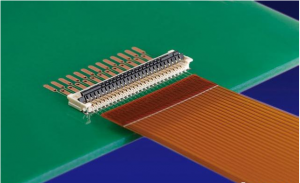Was ist der Unterschied zwischen flexibler Leiterplatte und herkömmlicher Leiterplatte? Wie unterscheidet sich die Anwendung?
xinst02. April 2020
FPC (flexible circuit board) is a type of PCB, also known as "soft board". FPC is made of flexible substrates such as polyimide or polyester film. It has the advantages of high wiring density, light weight, thin thickness, flexibility, and high flexibility. It can withstand millions of dynamic bending without damaging the wires According to the requirements of spatial layout, it can be moved and retracted arbitrarily to achieve three-dimensional assembly, which achieves the effect of component assembly and wire connection integration. It has advantages that other types of circuit boards cannot match.

FPC is widely used in mechanically sensitive equipment because its flexibility allows circuit boards to resist vibration. Flexible PCBs are more durable than traditional circuit boards, but flexible PCB manufacturing processes are sensitive and complex.
Flexible PCB applications
Rigid boards add some restrictions to product design because they cannot be installed in limited spaces. Circuit boards need to be vibration resistant in products that are often subject to mechanical shock.
Flexible PCBs are more suitable for this situation because they can be bent and wrapped if needed. They can survive harsh temperatures of -200 to 400 degrees Celsius. These features make flexible circuit boards more reliable and durable compared to traditional circuit boards.
Computers and accessories
Flexible PCBs are very powerful in terms of signal and atmospheric conditions. The hard drive in your computer contains a Flex PCB. Because these PCBs provide high data transfer rates on physically small circuit boards. Other electronic devices such as printers, calculators, and laptop LCDs are often designed with flexible PCBs for similar reasons.
aircraft
Aircraft electronic systems are often full of cables and are lightweight. A typical Airbus contains nearly 100 kilometers of cable, while a helicopter contains about 12 kilometers of cable. There is no compromise in terms of the reliability and performance of aircraft systems. The flexible PCB reduces weight and can be significantly improved even under mechanical shock, making it ideal for aircraft.
car
Over time, automotive products have become more compact. Flexible PCBs add compactness to their designs because, regardless of shape, these PCBs can be placed in limited space and still work efficiently. Flex PCB enables designers to produce lightweight products while maintaining product performance.
Flexible PCBs are commonly used in engine management computers, airbag controllers, and other electronic components in automotive products. Because automobiles are often exposed to high temperatures, which is tolerable for flexible PCBs, these boards have modern automotive products.
Mobile phone
The phone is small but has many features. Ever wondered how to design dense circuits in such a compact enclosure? Flexible PCBs can synchronize multiple components with minimal space requirements.
Connecting wiring harnesses or rigid boards for synchronization components is disadvantageous because the size and shape of the phone is limited. In addition, mobile phones will heat up, and traditional circuit boards cannot withstand high temperatures. In addition, Flex PCBs have added water resistance to their designs.
Medical electronics
Medical electronics need to be highly accurate and durable. Wearable devices currently under development are typically developed using Flexible PCBs, with the flexibility to make them suitable for host use.
Today, wearables are used to track physical health. These gadgets are very compact and sophisticated. Flex PCB can implant sensors on the patient's skin and monitor results on a smart watch or mobile phone. This revolution in wearable medical devices is brought about by flexible PCBs.
Medical devices often need to be placed inside the body, such as pacemakers or pill cameras that are often exposed to extreme atmospheric conditions and flexible PCBs are best suited for this situation.
Rigid PCBs are bulky and cannot use shape changes and low performance when transmitting high signals, which makes them detrimental to medical electronics.
Recent research on Flex PCB has enabled scientists to develop Flex PCBs that are more suitable for medical devices. These PCBs are developed using organic materials to provide more appropriate quality for prosthetic parts. These boards are more flexible than flexible traditional PCBs, which is exciting for the development of high-performance prostheses.
Industrial applications
Flexible Leiterplatten halten extremen Wetterbedingungen stand und arbeiten auch in rauen Umgebungen gut. HF-Geräte verwenden häufig Flex-PCB-Designs, da die Robustheit dieser PCBs die Signalstärke nicht beeinträchtigt. Darüber hinaus wird Flex PCB in Industriemaschinen und Steuerungssystemen für die Stromverteilung eingesetzt.
Sensor
Flex-Leiterplatten haben die Sensoren revolutioniert. Moderne Sensoren werden auf flexiblen Leiterplatten hergestellt, wodurch sich ihre Größe verringert. Diese Sensoren können in begrenzten und unregelmäßigen Räumen platziert werden, die für Design oder kompaktere Produkte geeignet sind.
Militärische Ausrüstung
Die meisten modernen militärischen Geräte verwenden flexible Leiterplatten wie Radarsysteme in Militärfahrzeugen. Steuerungssysteme in militärischen Geräten erfordern die Robustheit von Hochsignal- und Leitungswegen. Da das Gerät bei extremen Temperaturen verwendet werden muss, ist es oft schwierig, den Wetterbedingungen starren Leiterplatten standzuhalten. Darüber hinaus sind militärische Geräte häufig Vibrationen und mechanischen Belastungen ausgesetzt, die für flexible Leiterplatten leicht toleriert werden. Aus diesen Gründen eignet sich Flex PCB am besten für militärische Geräte.

